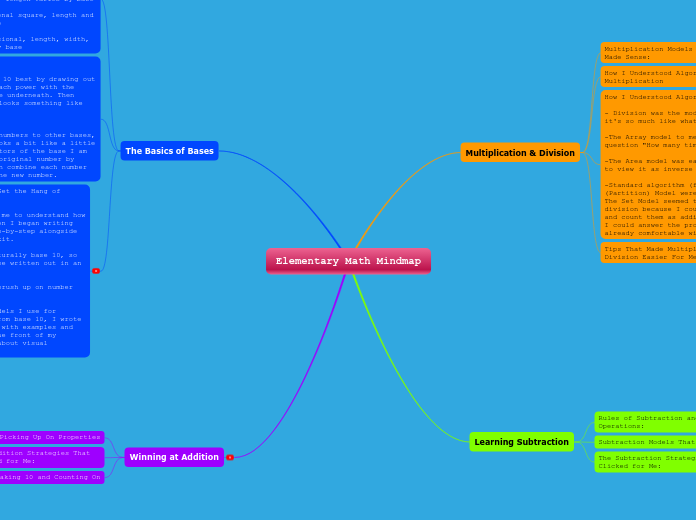
Multiplication Models That Just Made Sense:
How I Understood Algorithms of Multiplication
How I Understood Algorithms of Division
- Division was the model I picked up on the quickest because it's so much like what I learned in Elementary school.
-The Array model to me was the visual representation of the question "How many times can x go into y?"
-The Area model was easier for me to understand when I started to view it as inverse of multiplication as opposed to division.
-Standard algorithm (for bases other than 10 as well) and Set (Partition) Model were the two I was the most well-versed in. The Set Model seemed to me the simplest way to draw out division because I could map out/ group an entire number set and count them as addition instead.
I could answer the problem using a method (addition) that I was already comfortable with and good at.
Tips That Made Multiplication and Division Easier For Me:
Rules of Subtraction and Inverse Operations:
Subtraction Models That Just Made Sense:
The Subtraction Strategies That Just Clicked for Me:
The Difference Between A Unit, Long, Flat, and Cube:
Unit= a single block, always the same size no matter the base
Long= stick shape, length varies by base
Flat= two-dimensional square, length and width vary by base
Cube= three-dimensional, length, width, and height vary by base
Converting TO and FROM base 10:
-I learned how to convert to base 10 best by drawing out a chart and writing the base in each power with the number's corresponding place value underneath. Then turning it into an equation that looks something like this:
441 base three= (4x9)+(4x3)+(1x1)
-To learn how to convert base 10 numbers to other bases, I used the division model that looks a bit like a little house. I start by writing the factors of the base I am trying to convert to, divide the original number by those factors one-by-one, and then combine each number on the righthand column to make the new number.
Tips and Tricks to Get the Hang of Bases:
- It was easier for me to understand how to convert bases when I began writing out the problem step-by-step alongside the blocks from my kit.
-Every number is naturally base 10, so it doesn't need to be written out in an answer.
-It never hurts to brush up on number facts/factors
-To remember the models I use for converting to and from base 10, I wrote them on stcky notes with examples and stuck them inside the front of my notebook. It's all about visual repitition for me.
Picking Up On Properties
The Addition Strategies That Clicked for Me:
Making 10 and Counting On